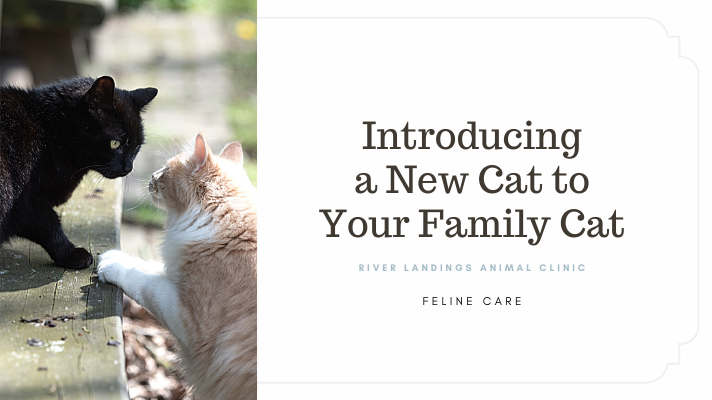Whether you already have a dog and are considering getting a cat, or vice versa, it is very important to think about their first introduction. By letting a loose cat and an off-leash dog meet each other in an open room for the first time, you are probably setting up both animals to fail. Instead, plan ahead and take your time.
Matching cats & dogs
If you’re thinking of getting a cat for your dog or a dog for your cat, it’s important to consider both animals’ personalities. It may be helpful to look for a companion that has already been exposed to the other species in the past.
If a dog attempts to aggressively chase, pin, pick up or otherwise “manhandle” any cat, it is best to not even consider getting a cat — or at least to proceed with caution. Additionally, a dog who growls, lunges at or obsessively barks at a cat would probably do best in a cat-free environment. Likewise, a cat who growls, swats at, runs from or hides from dogs would probably prefer to not live with a dog.
If a dog loves chasing things, then a fearful, shy cat who runs away probably wouldn’t be the best choice, as it could trigger the dog to chase. Similarly, an energetic cat who runs and pounces would fall into this same category. A better match here would be a calm, confident cat who will not run (in fear or play).
If a dog plays roughly, it is best to avoid kittens or elderly cats who can easily be hurt. Instead, stick to playful adults who are interested in play, but are also confident enough to take care of themselves. If a cat is rambunctious or playful, a dog that is playful, but gentle, could be a great option.
If a dog or cat is elderly, laid back, quiet or anxious, then a calm counterpart would be best. Avoid rambunctious companions who may annoy, frighten or otherwise bother the other pet.
The introduction process
Regardless of whether you are getting a new cat or a new dog, the first introduction between your current pet and your new pet is a very important part of the process. Here are four steps that can help you ensure a successful meeting:
STEP 1: CHOOSE THE PROPER LOCATION FOR THE FIRST MEETING
Resident cat to new dog: If you are adopting a dog, you should not take your cat to meet them at a shelter, or another establishment which houses a number of animals for health and safety reasons. Instead, the introduction should take place at home.
Resident dog to new cat: If you are adopting a cat, do not take your dog into a shelter and expose them to the cats, as this can be highly stressful or traumatic for all of the cats. Also, it is not necessarily a good indicator of how the dog will react at home. Instead, ask the shelter’s adoption counselors whether they have any dog-savvy, confident cats they will allow to meet your dog under controlled conditions. If this is not possible, an alternative would be to have your dog meet a dog-savvy cat who belongs to a friend or relative. As a last resort, you can bring your new kitty home and do an introduction at home.
STEP 2: SEPARATE THE ANIMALS
Across a few days, rotate which animal has the freedom and which is confined to allow each animal plenty of time to investigate the other one’s scent.
Sometimes the dog should be confined to a crate or another room (or taken to another location if they can’t be left alone) to allow the cat time to roam free and investigate the smell of the dog.
If the dog obsessively digs at the separation barrier or barks at the cat for more than a day or two, the interaction likely won’t work without proper training. You may need the help of a professional.
When no one is home, the dog or cat must always be securely confined so unsupervised interactions are not possible.
Once the dog is calm (or at least not obsessed with the cat) and the cat is calm, eating and using the litter box normally, you can proceed to the next step.
STEP 3: MAKE LEASHED INTRODUCTIONS
Allow both animals to be in the same room at the same time, but keep the dog securely leashed.
Continue with this type of introduction until the dog is calm and ignores the cat, and the cat is calm, eating, and using the litter box normally.
If there is any fear or aggression displayed on either animal’s part, stay at step 2 longer.
Continue indefinitely until both the dog and cat seem happy and relaxed around each other.
When no one is home, the dog or cat should be securely confined to separate areas so unsupervised interactions are not possible.
STEP 4: ALLOW UNSUPERVISED INTERACTIONS
Unsupervised time together can occur after the cat and dog have been supervised around each other for a significant period of time (a month or so) and you are positive they will not hurt each other.
TRAINING TIP:
If the dog stares at the cat or the door separating the cat, try to distract the dog and get the dog to look away with treats, a happy voice, or by gently guiding the dog away on a leash. Once the dog is away from the cat, try offering a treat. If the dog takes it, repeat this process until the dog is no longer focused on the cat or door.
Hear From Us Again
Don't forget to subscribe to our email newsletter for more recipes, articles, and clinic updates delivered to your inbox (here). Or, you can keep up to date by liking and following our Facebook page (here).
Related: We have more information under our cat health category.



